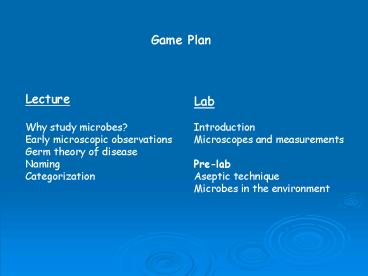Why study microbes - PowerPoint PPT Presentation
1 / 22
Title:
Why study microbes
Description:
Pre-lab. Aseptic technique. Microbes in the environment. Game Plan. Why study microbes? ... PRO/AH/EDR Yellow fever - South America (08): Brazil (RS) monkey, ... – PowerPoint PPT presentation
Number of Views:85
Avg rating:3.0/5.0
Title: Why study microbes
1
Game Plan
Lecture Why study microbes? Early microscopic
observations Germ theory of disease Naming
Categorization
Lab Introduction Microscopes and
measurements Pre-lab Aseptic technique Microbes
in the environment
2
Why study microbes??
3
Why study microbes??
INFECTIOUS DISEASE!
4
Why study microbes??
INFECTIOUS DISEASE!
- Salmonella outbreak
- 2008-2009 474 people infected with Salmonella
serotype - Typhimurium from peanut butter produced by Peanut
Corporation of - America (PCA).
- Staph infections at Miramar
- 2008 Recruits in the police academy contracted
staph infections - likely caused by the mat surface and spread by
skin to skin contact - XDR-TB in the USA
- 2007 Extensively drug resistant tuberculosis
(XDR-TB) in US - airline passenger extensively in California
- DRUG RESISTANT BACTERIAL OUTBREAKS
- MRSA (methicillin-resistant Staphylococcus
aureus) - C. diff (Clostridium difficile)
5
Recent infectious disease outbreaks
International Society for Infectious Diseases
PRO/AH/EDRgt Yellow fever - South America (08)
Brazil (RS) monkey, susp.
January 22, 2009
PRO/AH/EDRgt Salmonellosis, serotype Typhimurium -
USA (07) peanut butter
PRO/AH/EDRgt Undiagnosed illness, bovine -
Cambodia (PO), RFI
PRO/EDRgt Cholera, diarrhea dysentery update
2009 (09)
January 21, 2009
6
Emerging and re-emerging infectious diseases
- Definition New or changing diseases that are
increasing in incidence - or have potential to increase in the near future
- - Avian influenza A (H5N1)
- - Creutzfeldt- Jakob disease (CJD)- mad cow
disease - - Invasive Group A Streptococcus- flesh eating
bacteria - - Methicillin-resistant Staphylococcus aureus
(MRSA) - - Multidrug-resistant Mycobacterium tuberculosis
(TB) - - Hypervirulent drug-resistant Clostridium
difficile
7
What organisms cause disease?
Catalogued human pathogens Bacterial
538 Fungal 317 Helminthic 287 Viral 208 Proto
zoan 57 (Prions and viroids)
8
Why study microbes??
- INFECTIOUS DISEASE!
- Epidemiology frequency and distribution of
diseases (CDC, MMWR, ISID, etc.) - Immunology study of immune system to prevent
disease - Edward Jenner and vaccinations
9
Why study microbes??
- 2. Biotechnology
- - Food and industrial compound production
10
Why study microbes??
- 2. Biotechnology
- - Food and industrial compound production
- Chemotherapy treatment of disease with a
chemical - Synthetic drugs- man-made chemicals
- Ex. Paul Erlichs magic bullet
salvarsan against syphilis (1910) Gerhard
Domagks sulfa drugs (1930s) - Antibiotics- microbe-made chemicals
- Ex. Alexander Flemings penicillin
from Penicillium notatum
11
Why study microbes??
- 2. Biotechnology
- - Food and industrial compound production
- Chemotherapy treatment of disease with a
chemical - Synthetic drugs- man-made chemicals
- Ex. Paul Erlichs magic bullet
salvarsan against syphilis (1910) Gerhard
Domagks sulfa drugs (1930s) - Antibiotics- microbe-made chemicals
- Ex. Alexander Flemings penicillin
from Penicillium notatum - Genetic manipulation
- Genetic engineering
- Gene therapy
- Microbial insecticides
12
Why study microbes??
- Environmental
- Bioremediation- use of microbes or their enzymes
to degrade, - detoxify, or otherwise decontaminate
environmental hazards
Berlin biotechnology company uses
fungus Penicillium jantinellum to degrade plastic
in Trabant car
Pseudomonas spp. metabolize oil spill on Alaskan
shore
13
Why study microbes??
4. Microbiota - We are made up of more
bacterial cells than human cells! -
Roles Maintain health intestinal and vaginal
tracts, skin Cause disease oral microbiota,
overuse of antibiotics, opportunistic pathogens
14
How do we study microbes??
- We observe them
- 2. We characterize them
- 3. We name them
- 4. We categorize them
15
Observation- Spontaneous generation
- 4th century BC
- Aristotle proposes that decaying
- material could be transformed by
- the spontaneous action of Nature into
- living animals
- Examples
- Nile floods- frogs appear
- Carcass hangs in butcher shop- maggots appear
- Rain falls through thatched roof-
- spoils grain- mice appear
- Recipe for mice (Jan Baptista van Helmont, 1500s)
- Put dirty rag in a pot with grain and 21 days
later you will have mice
16
Observation- The microscope circa late 1600s
Robert Hooke and Anton van Leeuwenhoek
Figure 1.2
17
Biogenesis- Omne vivum ex vivo, OR no life
without antecedent life
- 1668- Francesco Redi
1837- Schwann (Schultze)
1864 Pasteur
1768- Spallanzani
18
Characterization- Germ theory of disease
1840s- Ignaz Semmelweis and handwashing
- 1860s- Joseph Lister and chemical
- disinfectants in surgery
19
Characterization- Germ theory of disease and
Kochs postulates
- Kochs postulates (1884)
- The same organism must be present in every
- case of the disease
- The organism must be isolated from the
- diseased host and grown in pure culture
- The isolate must cause the disease when
- inoculated into a healthy, susceptible animal
- The organism must be re-isolated from the
- inoculated diseased animal
- (page 426)
20
Naming- Binomial nomenclature
1730s Carolus Linnaeus
Genus species Escherichia coli or E. coli
Staphylococcus aureus or S. aureus Rickettsia
rickettsii or R. rickettsii
21
Categorization
Kingdoms of Life Monera Archaea Bacteria Protist
a Fungi Plantae Animalia
Domains of Life Archaea Bacteria Eukarya
22
Independent Study
- What factors are crucial in determining the
probability of a - disease being an EID or a re-EID?
- Which species of microbe are involved in the
production of - - Wine
- - Bread
- - Yogurt
- - Swiss cheese
- - Streptomycin
- What category do each of these microbes belong
to bacteria, - archaea, fungi, algae, or virus?































